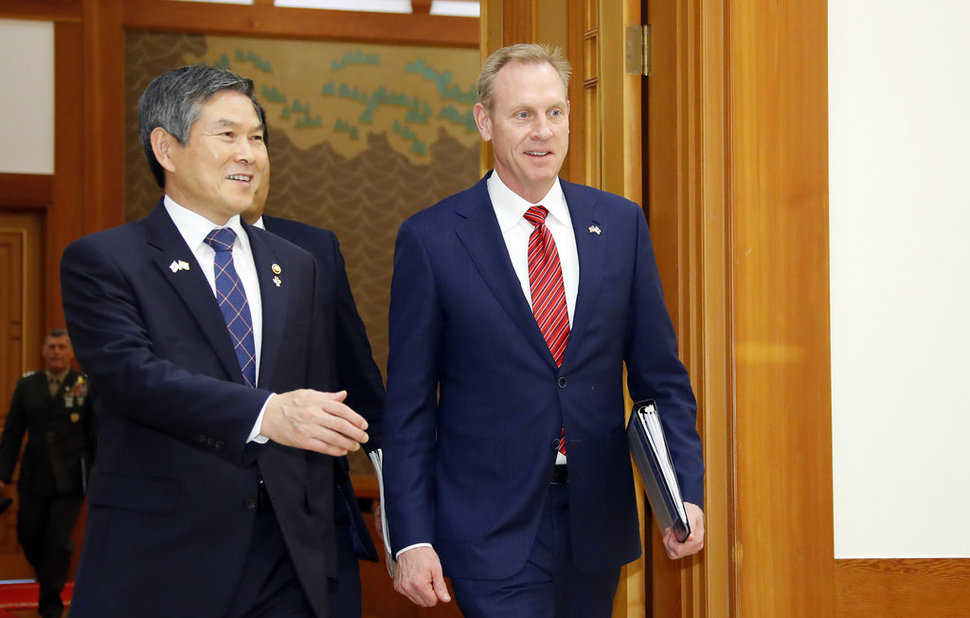 |
|
US Defense Secretary Patrick Shanahan with South Korean Defense Minister Jeong Kyeong-doo on their way to bilateral talks during the former’s visit to Seoul on June 3.
|
Critics cite the potential drift between the CFC and S. Korea’s JCS
The decision by South Korea and the US to relocate their Combined Forces Command (CFC) headquarters from Seoul’s Yongsan District to the US garrison Camp Humphreys in Pyeongtaek, Gyeonggi Province, is raising questions about the impact this will have on the South Korea-led future CFC. The approach to date, which had focused on relocating the CFC headquarters within the Ministry of National Defense (MND) complex, had the aim of uniting the alliance’s military capabilities around the South Korean military.
A relocation of the CFC headquarters to Camp Humphreys creates the exact opposite environment. Camp Humphreys is the current headquarters of the US Forces Korea Command and Eighth US Army command. It also houses the US 2nd Infantry Division and the ROK-US Combined Division headquarters. In effect, the CFC would be surrounded by the US military.
“If the CFC is located on a US military base, it seems likely that the US would end up with a stronger voice,” a military official said. The CFC headquarters will reportedly be established in a joint South Korea-US facility in Camp Humphreys.
Some are suggesting the CFC’s relocation to Pyeongtaek could result in problems communicating with the South Korean Joint Chiefs of Staff (JCS) in an emergency. According to this line of reasoning, the lack of opportunities to personally encounter JCS officials could lead to coordination difficulties. Communication between the South Korean and US militaries is a key element determining the efficiency of allied operations. The commander of the USFK Command, General Robert Abrams, reportedly voiced concerns about this issue while discussing the CFC’s relocation to Pyeongtaek.
But the MND explained that the problem would only be exacerbated if the CFC is located in the MND complex. Since most of the key staff officers in charge of planning, operations, and other areas for the CFC are also USFK Command staff, the dispersion with USFK would only increase if the CFC were situated in the MND complex, the ministry said.
“Currently, the CFC is exchanging information daily with the JCS through C4I [the command and communications system],” an MND senior official said.
“Once the CFC moves to Pyeongtaek, they’ll be working as a single unit with the USFK, which will increase allied operational efficiency,” the official added.
Relocation in consideration of “operational efficiency” and conditions for maximal professional performance
In addition to the matter of operational efficiency, the MND explained that the decision to relocate the CFC to Pyeongtaek was based on a close examination of practical matters such as conditions maximizing professional performance, the relocation dates and costs, and ensuring suitable conditions for the Yongsan base’s relocation. If the CFC were relocated to the MND complex, US military staffers and their family members would need to live near Yongsan. According to military estimates, each family would require an apartment measuring at least 83m². Establishing a separate C4I linking the Indo-Pacific Command, US Forces Japan Command, and USFK Command within the MND complex would cost an enormous amount.
“The money issue is there, but it would also be difficult to acquire that kind of space in practical terms,” an MND senior official said.
As recently as late 2018, South Korean and US defense authorities were exploring specific candidate sites for the CFC headquarters’ relocation within the MND complex. In October 2017, then South Korean Defense Minister Song Young-moo and then US Secretary of Defense James Mattis agreed on the CFC’s relocation to the MND complex in their 49th Security Consultative Meeting (SCM). Toward the end of that year, then CFC Commander General Vincent Brooks signed a related memorandum of understanding (MOU). Brooks also declared that the CFC would remain in Seoul.
The situation shifted when Abrams took over as USFK Commander in November 2018. Abrams reportedly ordered a reconsideration of the plan after a January tour of potential sites within the MND complex, including the JCS building, the Joint Warfighting Simulation Center (JWSC), MND facility headquarters, and the service support corps building.
But an MND official said the case was “based on a review by South Korea and the US at the alliance level.”
By Yoo Kang-moon, senior staff writer
Please direct comments or questions to [english@hani.co.kr]







